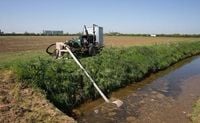Restrictions on water use have swept across eastern Scotland, as the Scottish Environment Protection Agency (Sepa) imposed the country’s highest level of water scarcity alert on multiple river catchments after months of relentless dry weather. On August 26, 2025, the Deveron catchment in Aberdeenshire joined the Ythan and North Fife regions under “significant scarcity”—a critical designation not seen since the 1970s, according to BBC reports. The move comes as rivers, soils, and groundwater buckle under the pressure of a rainfall shortfall that has persisted since June 2024.
These emergency measures, which limit the removal of water from rivers for industry and agriculture—a process known as abstraction—are being rolled out to protect the sustainability of local waterways. Farmers, in particular, are feeling the pinch. As highlighted by Farmers Weekly, the restrictions mark Scotland’s first water scarcity curbs of 2025, following a spring and summer that have been both unusually warm and dry. The Scottish Environment Protection Agency is now writing directly to every affected licence holder, urging them to reduce their water usage and follow the conditions of their licences.
Chris Dailly, Sepa’s head of environmental performance, summed up the gravity of the situation: “This is the driest we’ve seen this river (the Deveron) since the 1970s and it highlights how climate pressures are changing water availability in Scotland.” Dailly further explained, “The water environment in parts of Scotland is clearly under stress and protecting it remains a top priority. We recognise the challenges that farmers and other businesses face, but no one should be caught off guard—we’ve been speaking directly to licence holders across the summer.”
For those working the land, the timing couldn’t be worse. David Michie, food and farming senior policy manager at NFU Scotland, told Farmers Weekly that the restrictions are hitting growers hard, with key crops such as broccoli still requiring irrigation. “Building resilience must be a shared priority between growers, regulators and policymakers,” Michie emphasized, underscoring the need for long-term government support and co-investment in water management infrastructure.
Local politicians are also raising concerns. Willie Rennie, MSP for North East Fife, warned in The Scotsman that the restrictions could have a “devastating” impact on the local agricultural sector, where farmers have invested millions of pounds in crops. “Restricting water supply at this time of the season risks growth and yields which could mean farmers face significant losses and produce doesn’t reach the supermarket shelves,” Rennie said. He acknowledged efforts to increase boreholes and reservoirs, but cautioned that these measures have limits and called for Sepa to consider options to minimize the restrictions’ impact on the local economy.
The restrictions are not just a response to a single dry spell—they reflect a deeper, more persistent climatic trend. According to rainfall data cited by multiple outlets, every month of 2025 has been drier than average on Scotland’s east coast, with some regions experiencing a rainfall deficit of around 40% compared to the long-term average. Even short bursts of heavy rain in recent weeks have failed to revive rivers and reservoirs. The latest figures from Scottish Water show that reservoir levels in eastern Scotland last week were at just 56%—a full 25% below the usual 81% for this time of year.
Environmental engineering and hydrology expert Professor Lindsay Beevers, from the University of Edinburgh, told The National that while these alerts are serious, they are not cause for panic. “Floods and droughts are natural phenomena, they happen and what Sepa has to do is monitor the environment and issue alerts and it’s not something we are that used to in Scotland. We’re much more used to more water than less,” Beevers explained. She stressed that the public should be mindful of water use, especially for non-essential activities like washing cars or watering gardens, but essential water for drinking and hygiene remains secure. “We need to now become more aware we might not have all the water we want all the time,” she said.
Beevers also pointed out that water scarcity alerts are likely to become more common as climate change intensifies. “We will see more floods and more droughts, particularly in the north east where you’re seeing these water scarcity alerts [at the moment],” she said. The east of Scotland is especially vulnerable due to the way its river catchments drain and the region’s unique climate, which is influenced by the country’s mountainous terrain.
In response to the crisis, Sepa has made it clear that the restrictions are temporary and will be lifted as soon as conditions allow. The agency is closely monitoring the situation, especially as remnants of ex-Hurricane Erin are expected to bring rain to Scotland in the coming days. However, as BBC notes, Sepa has warned that unless there is sustained rainfall, other rivers in eastern Scotland—including the Don and the Lower Tweed—could soon be placed under significant scarcity as well.
Despite the severity of the current restrictions, Scottish Water has not issued a hosepipe ban (the last one was in 1995), nor are there immediate plans to do so. The focus, for now, is on limiting industrial and agricultural abstraction to safeguard both the environment and the communities that depend on healthy rivers. As Sepa put it, these measures are “essential to safeguard the environment, wildlife and communities that depend on healthy rivers.”
Yet, the situation is a stark reminder of the challenges ahead. As Willie Rennie observed, “This is yet another sign that we will need to adapt to the effects of climate change as these kinds of extreme events will occur more frequently. In 2023 we had extreme flooding, before that we had water scarcity and we’re back to water scarcity. Some work has been done but the scale of the change required is so much greater.”
Looking ahead, experts like Professor Beevers advocate for smarter water storage and use, especially in agriculture and industry. She suggested that building more reservoirs and small ponds across catchments could help store water during wetter months for use in drier periods. Such strategies may become increasingly important as Scotland faces a future marked by more erratic weather patterns and shifting water availability.
For now, the people of eastern Scotland are being urged to adapt, conserve, and prepare for a world where water—once taken for granted—must be managed with care and foresight.


